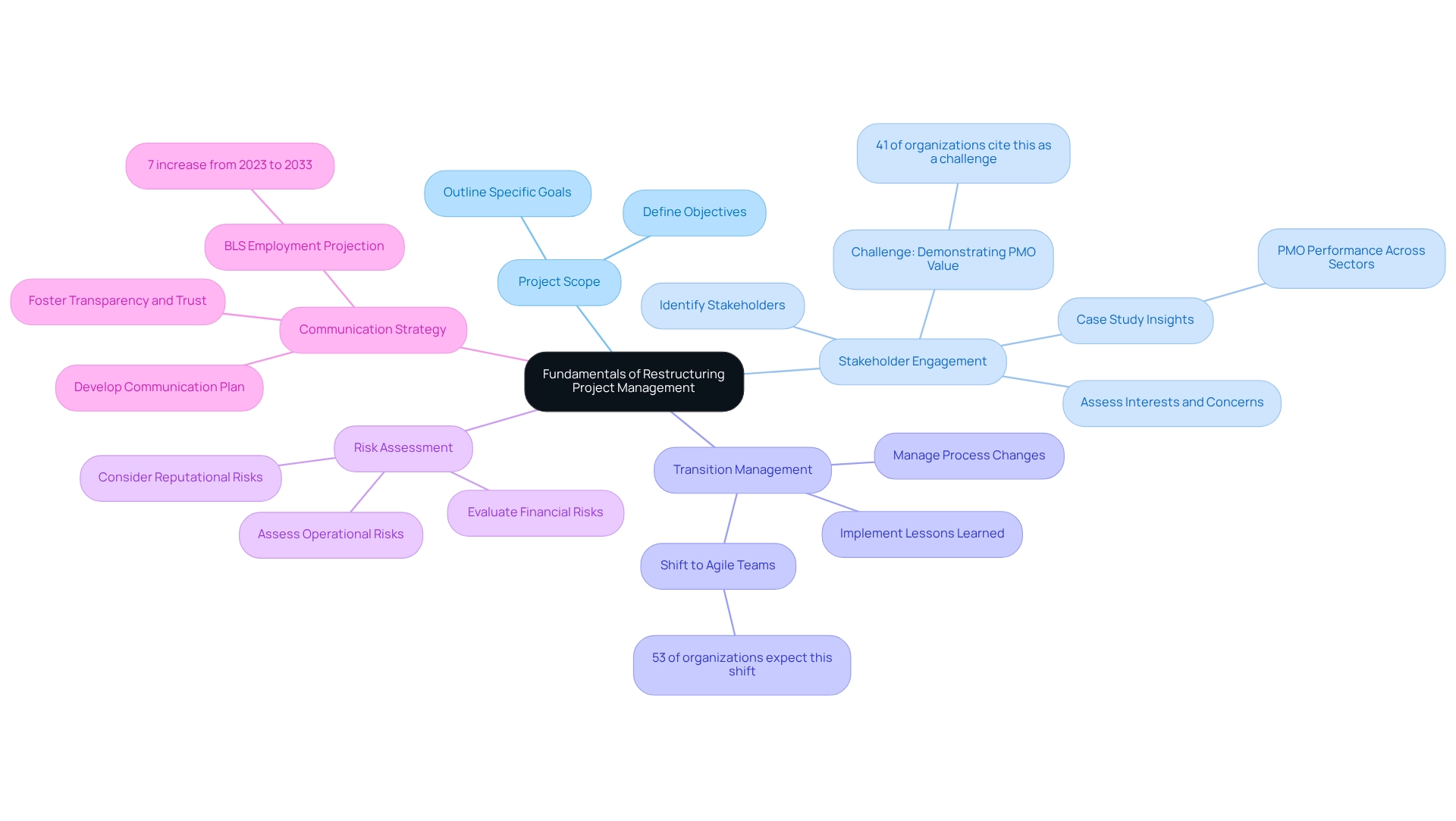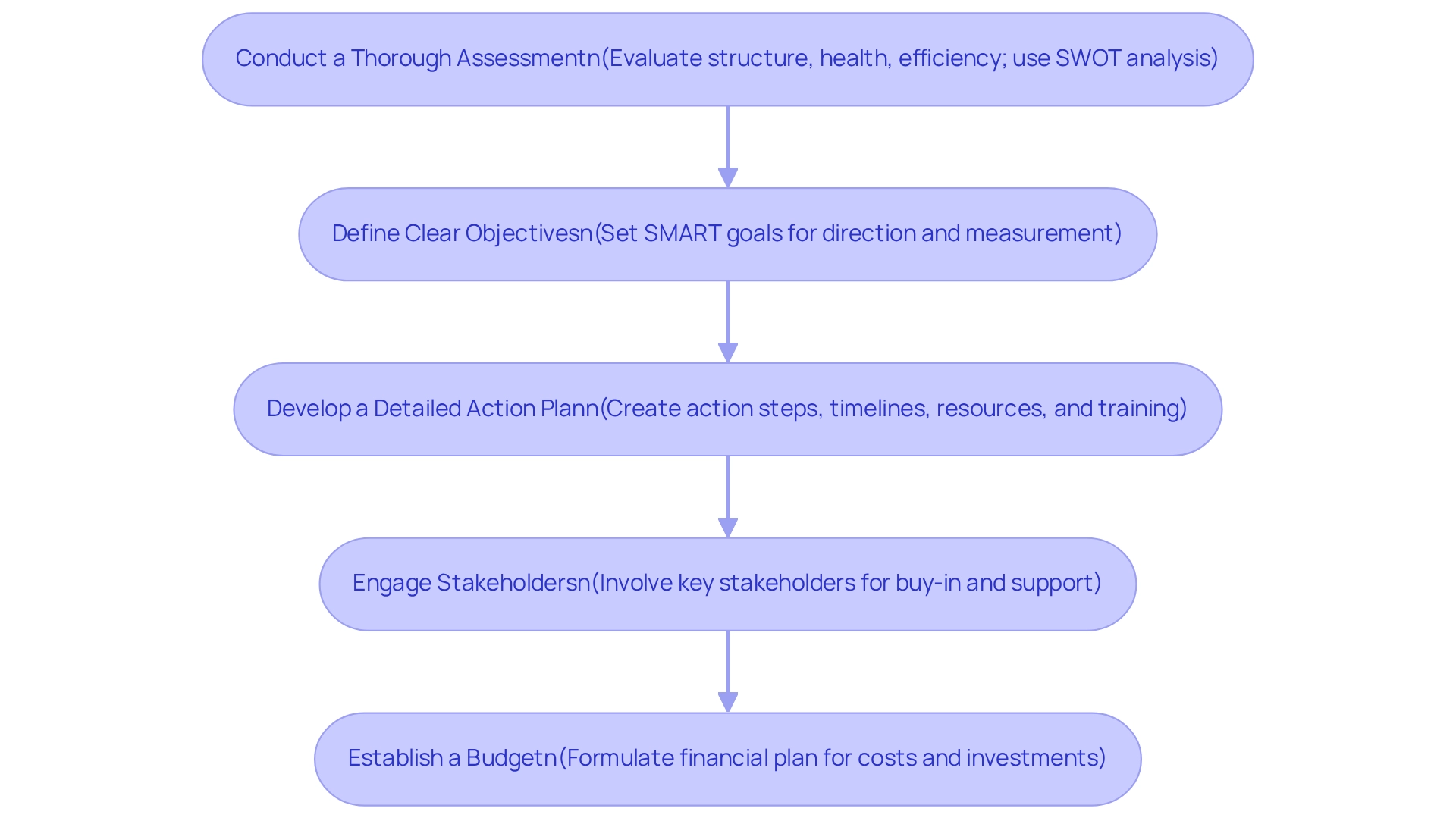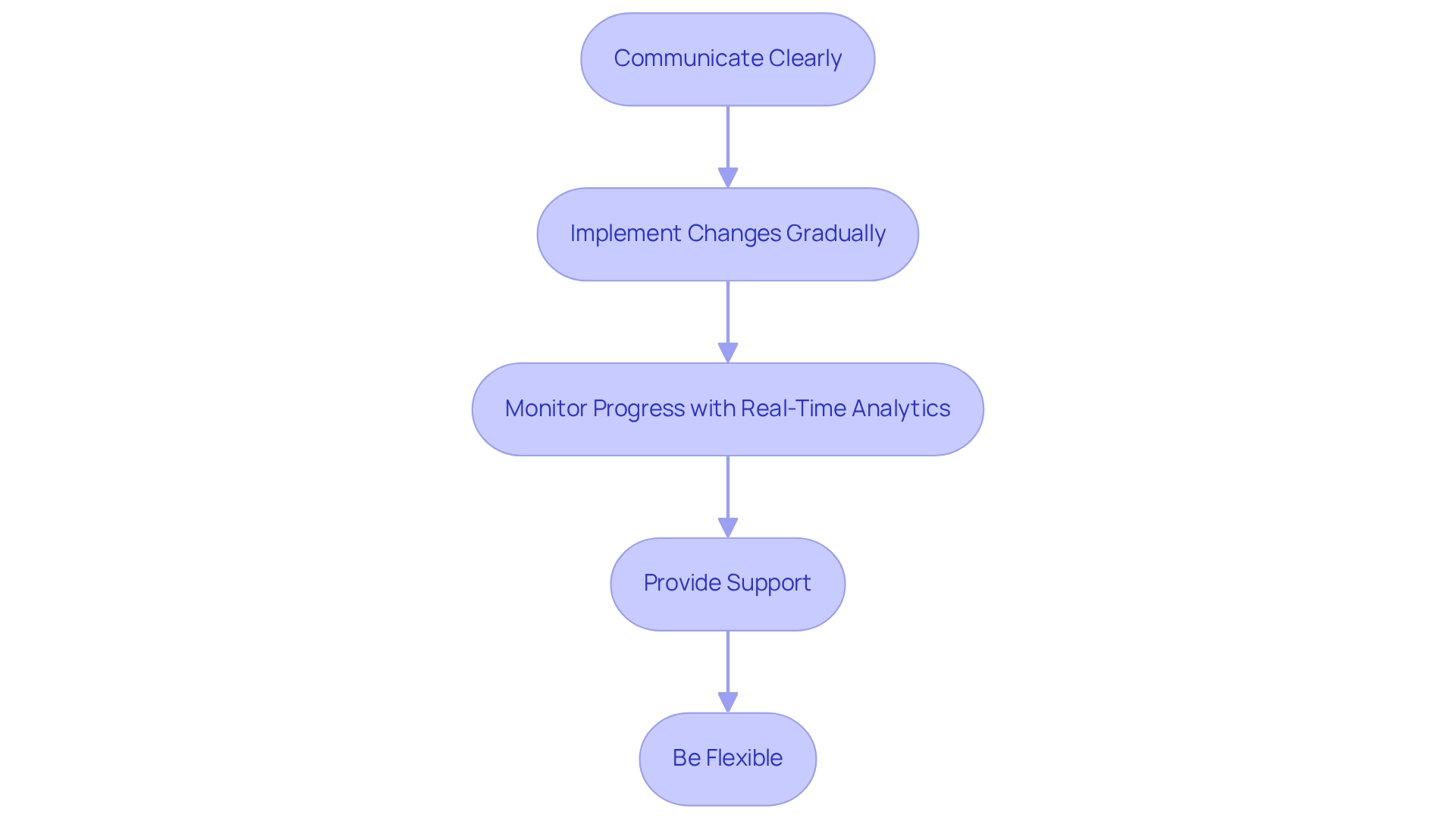Overview
Effective restructuring project management demands a strategic approach, encapsulated in four essential steps:
- Understanding project fundamentals
- Planning meticulously
- Executing with precision
- Monitoring outcomes
By engaging stakeholders, utilizing real-time analytics, and establishing clear objectives, organizations can adeptly navigate the complexities of restructuring. This adherence not only enhances operational efficiency but also significantly boosts the potential for sustainable growth. Consequently, organizations are urged to embrace these steps to ensure successful project management.
Introduction
In the dynamic landscape of modern business, restructuring projects have become a critical necessity for organizations striving to adapt and thrive. Navigating the complexities of such initiatives requires a profound grasp of project management principles tailored specifically to the unique challenges of restructuring. From defining clear objectives and engaging stakeholders to implementing effective change management strategies, the path to successful restructuring is paved with meticulous planning and execution. This article delves into the essential steps and best practices that organizations must adopt to ensure their restructuring efforts not only meet desired outcomes but also foster a culture of resilience and continuous improvement.
Understand the Fundamentals of Restructuring Project Management
Effectively managing a restructuring project management demands a solid understanding of key project management principles tailored to this unique context. Begin by familiarizing yourself with the following core concepts:
- Project Scope: Clearly define the objectives of , outlining specific goals to guide the procedure.
- Stakeholder Engagement: Identify all stakeholders, including employees, investors, and customers, and assess their interests and concerns. Engaging stakeholders is crucial, as 41% of organizations cite demonstrating the added value of project management offices (PMOs) as a significant challenge. Moreover, insights from the case study titled "PMO Performance Across Sectors" indicate that effective stakeholder engagement can significantly enhance PMO performance across various industries.
- Transition Management: Recognize that restructuring frequently involves significant alterations in processes and staff. Establishing a strong restructuring project management strategy is essential to ensure seamless shifts and reduce opposition. Notably, 53% of organizations expect to shift toward working in smaller, more agile teams, which underscores the need for adaptable change management practices. Furthermore, implementing lessons learned from past organizational changes can enhance relationships and boost future results.
- Risk Assessment: Conduct a thorough evaluation of potential risks associated with the reorganization, encompassing financial, operational, and reputational factors. This proactive approach to restructuring project management can mitigate adverse impacts on the organization.
- Communication Strategy: Develop an extensive communication plan to keep all stakeholders informed and involved during the reorganization. Effective communication is crucial in restructuring project management as it fosters transparency and trust, which are essential for successful outcomes. As the Bureau of Labor Statistics (BLS) notes, project manager employment is expected to increase by 7% from 2023 to 2033, highlighting the growing importance of skilled project management in navigating these complex processes.
By mastering these essential principles, including the use of real-time analytics to monitor business performance and support swift decision-making, you will be well-prepared to navigate the complexities of project management changes, ultimately steering your entity toward sustainable growth.

Plan Your Restructuring Project Effectively
Effective planning is essential for successful restructuring project management. Here are the essential steps to guide your efforts:
- Conduct a Thorough Assessment: Begin by evaluating the current organizational structure, financial health, and operational efficiency. Utilize a SWOT analysis to identify strengths, weaknesses, opportunities, and threats. This foundational step is vital, as organizations that leverage data analytics in their assessments are twice as likely to achieve their change management goals. The case study named "Data-Driven Change Management" demonstrates how data-informed insights can lead to more focused and effective strategies in reorganization. Moreover, utilizing can assist in consistently assessing your business health during the restructuring project management process.
- Define Clear Objectives: Establish specific, measurable, achievable, relevant, and time-bound (SMART) goals for your reorganization initiative. Setting clear objectives not only provides direction but also facilitates the measurement of progress and success. This clarity supports a streamlined decision-making cycle, allowing your team to take decisive actions as needed.
- Develop a Detailed Action Plan: Create a comprehensive action plan that outlines the necessary steps to achieve your objectives. This should include timelines, resource allocation, and clearly defined responsibilities. As Gartner emphasizes, digital transformation strategies should encompass training programs that equip employees with the skills they need for new systems. Including training in your action plan is crucial for managing the challenges of reorganization. Furthermore, continuously updating and adjusting your plan based on real-time analytics will enhance its effectiveness.
- Engage Stakeholders: Involve key stakeholders throughout the planning process. Their insights and concerns are invaluable for fostering buy-in and support, which are critical for the success of the restructuring efforts. It's important to manage change effectively in restructuring project management; Gallup's survey reports that 74% of employees feel overwhelmed when multiple changes are introduced in quick succession. Building strong relationships with stakeholders can facilitate smoother transitions and operationalize the lessons learned during the turnaround process.
- Establish a Budget: Formulate a financial plan that details the costs associated with the reorganization. This should encompass potential savings and necessary investments for implementation. A clear budget aids in managing resources effectively and ensuring financial viability.
By carefully adhering to these steps and incorporating real-time analytics into your planning, you will establish a strong foundation for restructuring project management, significantly increasing the chances of achieving your desired outcomes.

Execute the Restructuring Plan with Precision
Meticulous coordination and a strategic approach are essential for effective restructuring project management.
- Communicate Clearly: Keeping all stakeholders informed about , including timelines and individual roles, is essential. Transparency fosters trust and encourages buy-in from all parties involved. Communication should occur at both organizational and individual levels to ensure everyone is aligned and engaged.
- Implement Changes Gradually: Introducing changes in phases allows for adjustment and feedback, significantly reducing resistance and confusion. This phased approach not only eases the transition but also enhances the likelihood of successful adoption. Notably, by 2025, 75% of businesses will shift more often to stay competitive, underscoring the necessity for adaptability in transformation efforts.
- Monitor Progress with Real-Time Analytics: Establish clear metrics to track the execution of the reorganization plan. Utilizing real-time business analytics through a client dashboard enables continuous monitoring of performance and health, ensuring that the initiative stays on course and allowing for timely adjustments. Regularly reviewing progress against the objectives set during the planning phase is crucial for effective decision-making.
- Provide Support: Offering resources and assistance to employees affected by the organizational changes is crucial. This encompasses training and counseling services to assist them in adjusting to new roles or procedures, thereby reducing disruption and preserving morale.
- Be Flexible: Adaptability is key. Be prepared to modify the restructuring project management plan based on feedback and unforeseen challenges. This flexibility ensures that the restructuring project management remains aligned with organizational goals and can respond effectively to changing circumstances. Implementing insights gained from the turnaround process can improve relationships and boost future initiatives.
As Gartner pointed out, successful entities find a balance between allowing employees the freedom to explore new ideas and establishing guidelines to maintain alignment with the overall transformation strategy. By executing the plan with precision and a focus on communication, entities can facilitate a smoother transition and achieve the desired outcomes. Statistics indicate that effective communication during organizational transformation can greatly improve success rates, as numerous companies encounter elevated failure rates in adaptation efforts, frequently between 60-70%. Therefore, prioritizing clear communication, phased implementation, and leveraging real-time analytics is not just beneficial but essential for sustainable growth. Insights from case studies on challenges in change management reveal that focusing on clear communication, thoughtful planning, and employee involvement can transform change from a challenge into an opportunity for growth.

Monitor and Evaluate the Restructuring Outcomes
To ensure the success of your restructuring project, it is crucial to monitor and evaluate the outcomes effectively:
- Set Key Performance Indicators (KPIs): Establish specific metrics to assess the success of the organizational changes. Key indicators may include financial performance, employee satisfaction, and operational efficiency. According to studies, organizations that monitor employee satisfaction post-restructuring often see a 20% increase in engagement levels. These metrics provide a clear framework for assessing progress and outcomes. As Tim Stobierski notes, "Understanding how these metrics influence business strategy is for all managers to develop."
- Conduct Regular Reviews: Implement a schedule for periodic evaluations against the established KPIs. Frequent evaluations promote early detection of possible problems, allowing prompt modifications to the strategy. This proactive approach is essential for maintaining momentum and ensuring alignment with organizational goals. Our team endorses a shortened decision-making cycle during the turnaround phase, enabling your team to take decisive action to safeguard your business.
- Gather Feedback: Actively solicit input from stakeholders, including employees and management. Comprehending their viewpoints on the reorganization and its results can offer valuable insights that guide essential modifications and improve overall efficiency. By putting into practice the lessons learned through the turnaround process, entities can build stronger relationships and promote a culture of continuous improvement.
- Analyze Financial Results: Thoroughly review financial statements and performance reports to assess the changes' impact on the organization’s bottom line. This analysis is vital for understanding the financial health of the business post-restructuring and for making informed decisions moving forward. For example, monitoring the lead conversion ratio can act as an essential metric for evaluating the effectiveness of the sales funnel during reorganization. We are pragmatic in our approach to data, testing every hypothesis to deliver maximum return on invested capital in both the short and long term.
- Document Lessons Learned: Capture insights and lessons from the reorganization process to inform future initiatives. This documentation not only aids in refining strategies but also contributes to building organizational resilience, ensuring that the business is better equipped to handle future challenges. By continually monitoring the success of our plans through real-time business analytics, companies can diagnose their business health effectively.
By diligently monitoring and evaluating these outcomes, organizations can ensure that their restructuring efforts achieve their intended goals and contribute to sustainable long-term success.

Conclusion
Successfully navigating a restructuring project hinges on understanding and implementing key project management principles, effective planning, and precise execution. By grasping the fundamentals—such as defining project scope, engaging stakeholders, and managing change—organizations can carve a clear path through the complexities of restructuring. Conducting thorough assessments and establishing SMART objectives lays a strong foundation for targeted actions, while a well-structured communication strategy fosters trust and transparency among all involved parties.
As the restructuring plan unfolds, monitoring progress through real-time analytics and maintaining flexibility for adjustments are crucial. Gradual implementation and ongoing support for employees can help mitigate resistance and enhance morale, ultimately driving successful adoption of changes. Regular evaluations against established KPIs ensure that the restructuring remains aligned with organizational goals, while gathering feedback from stakeholders informs necessary adjustments that promote a culture of continuous improvement.
In conclusion, a successful restructuring initiative is not merely about achieving immediate goals; it is about fostering resilience and adaptability within the organization. By meticulously following best practices in project management, planning, execution, and evaluation, organizations can transform challenges into opportunities for sustainable growth. Embracing this proactive approach empowers organizations to not only navigate current changes but also thrive in an ever-evolving business landscape.
Frequently Asked Questions
What is the importance of defining project scope in restructuring project management?
Clearly defining the project scope involves outlining specific objectives and goals for the reorganization initiative, which guides the entire procedure.
How should stakeholders be engaged during a restructuring project?
Stakeholders, including employees, investors, and customers, should be identified and their interests and concerns assessed. Engaging stakeholders is crucial, as it can enhance project management office (PMO) performance and address the challenge of demonstrating added value.
What is transition management in the context of restructuring?
Transition management involves recognizing significant changes in processes and staff during restructuring. A strong management strategy is essential to ensure smooth transitions and reduce resistance, especially as organizations shift toward smaller, more agile teams.
Why is risk assessment important in restructuring project management?
Conducting a thorough risk assessment is vital to evaluate potential financial, operational, and reputational risks associated with the reorganization. This proactive approach helps mitigate adverse impacts on the organization.
What role does communication strategy play in restructuring?
An extensive communication plan is essential to keep all stakeholders informed and involved during the reorganization. Effective communication fosters transparency and trust, which are critical for successful outcomes.
How can real-time analytics support restructuring project management?
Utilizing real-time analytics allows for monitoring business performance and supports swift decision-making, which is crucial for navigating the complexities of project management changes and steering the organization toward sustainable growth.




